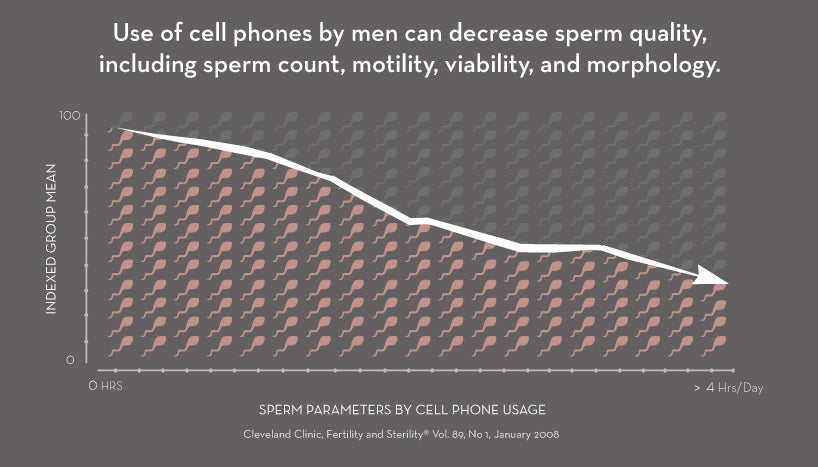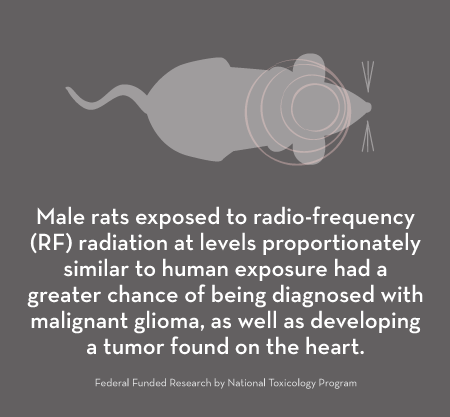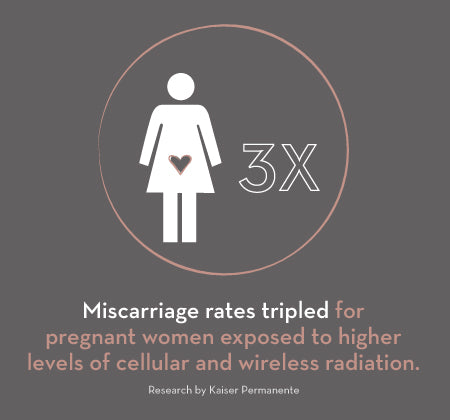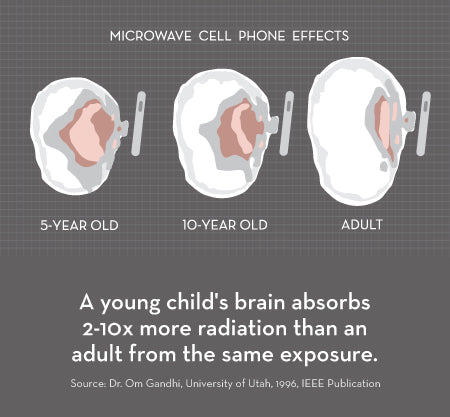Research on Health Impact
What are the health risks from electromagnetic radiation (EMR)?
EMR has long been cited as a health risk to people, particularly young children and developing fetuses, but scientific experts still debate the nature and extent of that risk. What we do know is that radiation at the levels emitted by cell phones and Wi-Fi does have a biological impact. Numerous studies have shown that it impacts the way cells grow, DNA replicates, and brain cells function.
Because of this, health experts believe early childhood and pregnancy – when rapid and complex cell development occurs – are the times of highest risk. In addition, this radiation presents an increasing risk to all populations as cellular and wireless technologies proliferate.
Given the emerging scientific evidence, numerous health experts and governments worldwide are recommending the "precautionary principle" towards these risks until we know more, especially during pregnancy and early childhood. (Read under Regulations about how more than 20 countries and governments have enacted protective policies.) They draw parallels with other toxins such as tobacco and asbestos, which took decades for policy and awareness to catch up with emerging scientific evidence. Because the dangers caused by radiation can take years to show their effects, and increasing numbers of people are being exposed for longer durations, most scientists agree that more studies must take place.
Rapidly proliferating electromagnetic field emissions is "a ubiquitous environmental exposure and a serious looming public health challenge".
Fertility
Today, more than 5 million people in the U.S. suffer from infertility.
Multiple studies have linked EMR exposure to lower fertility in both men and women, but more research has been done about its impact on men’s fertility.
Sperm count and quality have been decreasing, and ~20% of young men are sub fertile:
- In 2010, a European Science Foundation Report reported that at least one in five 18-25 year-old men in Europe were "subfertile". In addition, sperm count and quality have been dropping consistency in the developed world over recent decades, falling up to 20-30% over the past decade alone.
- Men’s sperm count and sperm concentration have decreased more than 50% from 1973 to 2011, according to a meta-analysis of hundreds of studies covering nearly 43,000 men in 50 countries, published in Human Reproduction Update published by Oxford University Press.
- Some potential factors cited by researchers for the decrease in sperm health include cigarette smoke, synthetic chemicals, alcohol, stress, obesity and age, as well as the increasing use of cell phones.
- Research by the Cleveland Clinic in 2007 found that men who use cell phones for 4 hours a day had 25% lower sperm count than those who don’t use cell phones. Of the sperm they did have, 80% were not properly formed, and motility (a measure of swimming ability and a crucial factor in conception) was down by a third. (Read more here.)
- Other studies have found similar results, such as the 2011 study by Queen’s University of Kingston, Ontario which looked at 2,100 men and found a “significant difference” in sperm count between men who used cell phones and those who did not. Additionally, this study found cell phone radiation decreased the luteinizing hormone, a significant reproductive hormone secreted in the male brain.

"Pregnant women and couples trying to conceive children should minimize their exposure to the electromagnetic fields produced by household appliances and wireless devices, including cell phones.”
<< Back to main Research Page
Miscarriages
“Electromagnetic field radiation has a biological effect.”
- Dr. De-Kun Li, senior research scientist at Kaiser Permanente Northern California
- According to a study conducted by Kaiser Permanente North California and funded by the National Institute of Environmental Health Sciences of more than 900 pregnant women in the San Francisco area, miscarriage rates tripled for women who were exposed to higher levels of radiation from sources such as cell phones, wireless devices and cell phone towers than women who were exposed to lower levels. While the study does not establish causation between non-ionizing radiation and miscarriages, it does establish the link between the two. The research is particularly compelling because this examines a short-term impact of EMF that can more easily draw correlations between exposure and health outcome, unlike cancer, which can take years to develop and need longer time to study.
- A case-control study published in the Journal of Environmental Health Science and Engineering of approximately 600 women showed an increased risk of miscarriages associated with EMF exposure. “Electromagnetic fields may produce biological stress and free radicals, which can make a susceptible population prone to congenital malformations and tissue and cell damages. Long-term exposure to electromagnetic fields may be linked to even higher levels of oxidative stress”.
- Research has found evidence tying magnetic field exposure — especially the type from video display terminals such as those in computers and televisions — to increased risk of miscarriage (Lee et al. 2002, Juutilainen et al. 1993, Lindbohm et al. 1992). Proximity to power lines has also been linked to miscarriage (Li et al. 2001, Robert et al. 1996). In both cases, the associations are especially strong for early stage pregnancies.
"We really want people to start rethinking the assumption that magnetic-field exposure is safe. We really, really need more research because everybody is exposed, including the genetically vulnerable and fetuses.”
<< Back to main Research Page
Behavioral

“The rise in behavioral disorders in human children may be in part due to fetal cellular telephone irradiation exposure.”
- Dr. Hugh S. Taylor, professor and chief of Reproductive Endocrinology and Infertility, Yale School of Medicine
-
Research conducted by the Yale School of Medicine found that mice exposed to cell phone radiation as fetuses tended to be more hyperactive and had reduced memory capacity. The researchers attributed the behavioral changes to an effect during pregnancy on the development of neurons in the prefrontal cortex region of the brain. “We have shown that behavioral problems in mice that resemble ADHD are caused by cell phone exposure in the womb,” said Dr. Hugh S. Taylor, senior author and professor and chief of the Division of Reproductive Endocrinology and Infertility in the Department of Obstetrics, Gynecology & Reproductive Sciences at Yale School of Medicine.
-
A 2010 study by researchers at UCLA spanning 29,000 children found that by age 7, there was a 50% increase in behavioral problems for children that had “regular exposure” to mobile phones in the womb and during early childhood. The behavioral problems included hyperactivity, attention disorders, and social issues. Similar findings came out of an early study of 13,000 Danish children. According to these studies, the more frequently a mother used a cell phone, the greater the risk that her child would have a behavioral problem. Mechanisms behind the connection have not been established, though it has been theorized that the radiation from cell phone use may affect the regulation of hormone secretion impacting metabolism and brain development.
-
More research is also emerging that show the physiological impacts of EMR and its potential to cause autism spectrum conditions (ASC). Dr. Martha Herbert, a Pediatric Neurologist and Neuroscientist at Massachusetts General Hospital and Assistant Professor of Neurology at Harvard Medical School who has focused her clinical, research, and advocacy over 20 years on autism, published research in the medical journal Pathophysiology (2013, Part I and Part II), concluding that “EMF/RFR exposure [can] add to system overload ('allostatic load') in ASCs by increasing risk, and worsening challenging biological problems and symptoms; conversely, reducing exposure might ameliorate symptoms of ASCs by reducing obstruction of physiological repair.”
“The evidence is sufficient to warrant new public [EMR] exposure standards benchmarked to low-intensity (non-thermal) exposure levels now known to be biologically disruptive, and strong, interim precautionary practices are advocated.”
- Dr. Martha Herbert, Pediatric Neurologist and Neuroscientist at Massachusetts General Hospital, Autism Specialist, Harvard Medical School
<< Back to main Research Page
Developmental
Small but pervasive changes to cellular and genetic processes early in life can have developmental effects -
especially for children, whose brains are rapidly developing and whose tissues absorb relatively larger amounts of radiation than adults.
- According to The New York Times and renowned researchers like Dr. Henry Lai of the University of Washington who study the biological effects of radiation from wireless communication, 67% of studies that were not funded by the wireless industry itself have found there to be adverse biological impact from cell phone radiation, versus 28% of the studies funded by the cell phone industry. The biological impacts found primarily fall into 3 categories: cellular growth, DNA replication, and neurological functioning.
- Multiple research studies show that children absorb cell phone radiation deeper into their brains than adults, because children’s skulls are thinner and their brains contain more absorptive fluid, such as the research by Dr. Om Gandhi (Department of Electrical and Computer Engineering, University of Utah) and by Dr. Devra Davis (renowned cancer expert, Founding Director of the Center for Environmental Oncology at University of Pittsburgh Cancer Institute, and former Senior Advisor to the Department of Health and Human Services).
- The impact on cellular growth has ranged from observed cell growth retardation and cell damage to impaired cell attachment (Aldinucci et al. 2003, Buemi et al. 2001, Pacini et al. 1999, Raylman et al. 1997, Linder-Aronson & Lindskog 1995). At the genetic level, altered gene expression (Hirose et al. 2003, Hirai et al. 2002) and altered fetal development – specifically of the cardiovascular systems (Okazaki et al. 2001) – has been observed.
- Most of the studies to date have been conducted in controlled laboratories, so it is difficult to say how this manifests in the population at large as the effects may take decades to express themselves. Additionally, radiation exposure today is orders of magnitude greater than 15 years ago. However, the concern is that small but pervasive changes to cellular and genetic processes early in life will have developmental effects, especially for children whose brains are rapidly developing and their tissues absorb relatively larger amounts of radiation than adults.
“Children are not miniature adults… because of their smaller size, their anatomical and morphological characteristics and the characteristics of some of their tissues, they are more exposed. In particular, the peripheral areas of their brains are more vulnerable than adults to EMR.”
- Olivier Merkel, Head of the Evaluation Unit of the Risk of Physical Agents, National Health Agency of France
<< Back to main Research Page
Cancer

The World Health Organization has classified cell phone radiation in the same potentially carcinogenic category as chloroform, lead, and engine exhaust.
This conclusion draws on research that has found a greater risk for glioma, a malignant type of brain cancer, associated with cell phone usage.
- Cancer is one of the most discussed impacts from everyday radiation. Evidence has been found of relationships with multiple types of cancer including breast cancer, hematological cancers, and brain cancer.
- The largest study of cell phone use and brain cancer is the Interphone Case-Control Study involving 13 developed countries except the U.S. While the increased risk of brain cancer was not established from this study of 30-59 year-olds brain cancer patients, the research did show that people who used a cell phone for 10+ years had double the risk of developing brain gliomas, a type of tumor. The Director of the WHO’s International Agency for Research on Cancer (IARC) said, "Observations at the highest level of cumulative call time and the changing patterns of mobile phone use since the period studied by Interphone, particularly in young people, mean that further investigation of mobile phone use and brain cancer risk is merited."
- In May 2016, results from a multi-year, federally funded study by the National Toxicology Program showed that male rats exposed to radio-frequency (RF) radiation had a greater chance of being diagnosed with a brain cancer called malignant glioma, as well as developing a tumor found on the heart. The radiation levels the rats were exposed to were near federal safety limits similar to what humans would be exposed to.
- A 2017 report in the American Journal of Epidemiology confirmed that Canadians who used cellphones for 558 hours or more in their lifetime have more than double the risk for glioma, an aggressive brain cancer. The findings strengthened the association between glioma and cell phone use.
- Childhood leukemia and other hematological cancers (lymphoma and multiple myeloma) have been shown in multiple studies to be associated with low-frequency magnetic fields, such as those from power lines. A causal biological mechanism is not understood, but the association has been found to have strong statistical significance. In 2002, the IARC classified these magnetic fields as “possibly carcinogenic to humans,” based on the demonstrated “consistent pattern of a two-fold increase in childhood leukemia associated with average exposure to residential power-frequency magnetic fields.”
<< Back to main Research Page
Click the icons below to learn more about wireless radiation.



